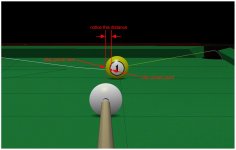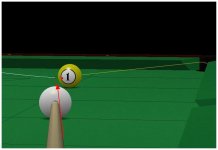I think that, no matter what "system" we use (or none at all), we basically memorize how successful shots look to us and then try to duplicate that picture when the same shots arise again. It's difficult to memorize how much two discs (CB and OB) overlap for many different cut angles, so many aiming systems try to help by giving us specific visible landmarks on the balls to align (edges, centers, etc.).
My "aiming memory" system is a similar approach, but very simplified. It compares the alignment of the same two things every time: where your stick points in relation to the OB contact point. There's no special way to use this information - all you do is take note of the distance between the two for each shot, and your "aiming memory" will, without any further assistance from you, develop much more quickly and accurately.
For instance, here's a typical half-ball shot showing the "measurement" I make:

pj
chgo
My "aiming memory" system is a similar approach, but very simplified. It compares the alignment of the same two things every time: where your stick points in relation to the OB contact point. There's no special way to use this information - all you do is take note of the distance between the two for each shot, and your "aiming memory" will, without any further assistance from you, develop much more quickly and accurately.
For instance, here's a typical half-ball shot showing the "measurement" I make:

pj
chgo
